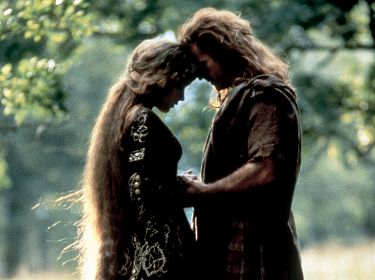As part of this project, I plan to look at a review of each movie I watch that is written by an actual critic. For the movie Braveheart, I looked at a review written by Roger Ebert. His review not only serves as an excellent summary of the majority of the movie, but also gives me a little hope that my thoughts on the movie were pretty accurate. One of the first things Ebert mentions in his review is the battle scenes of the movie, I also noticed the techniques used in battle and how realistic they seemed. Another aspect of the movie that he mentions is of the scene after Murron and William Wallace get married and they are standing in front of the waterfall and the only thing serving as a light source is the moon reflecting on the water. The last paragraph of Ebert's review basically talks about how the movie was very well thought out, and the techniques used were very effective, these thoughts matching mine about the movie as a whole.
BraveheartBY
ROGER EBERT / May
24, 1995
Not much is
known about Wallace, known as Braveheart, except that according to an old epic
poem, he unified the clans of Scotland and won famous battles against the
English before being captured, tortured and executed as a traitor.
And as
Braveheart, Gibson plays his role with flamboyance, and cuts it with sly humor.
He is an amazing battlefield strategist, inventing new strategies and weapons,
outsmarting the English at every turn, leading his men into battle with his face
painted blue, like a football fan. There is a scene where he is so pumped up
with the scent of battle that his nostrils flare; not many actors could get
away with that, but Gibson can.
Here's the link to the review posted above:
Mel Gibson's "Braveheart" is a fullthroated,
red-blooded battle epic about William Wallace, the legendary Scots warrior who
led his nation into battle against the English in the years around 1300. It's
an ambitious film, big on simple emotions like love, patriotism and treachery,
and avoids the travelogue style of so many historical swashbucklers: Its
locations look green, wet, vast, muddy and rugged.
Wallace's
dying cry, as his body was stretched on the rack, was "freedom!" That
isn't exactly based on fact (the concept of personal freedom was a concept not
much celebrated in 1300), but it doesn't stop Gibson from making it his dying
cry. It fits in with the whole glorious sweep of "Braveheart," which is an action epic with
the spirit of the Hollywood swordplay classics and the grungy ferocity of
"The Road Warrior." What people are going
to remember from the film are the battle scenes, which are frequent, bloody and
violent. Just from a technical point of view, "Braveheart" does a brilliant job of
massing men and horses for large-scale warfare on film. Gibson deploys what
look like thousands of men on horseback, as well as foot soldiers, archers and
dirty tricks specialists, and yet his battle sequences don't turn into
confusing crowd scenes: We understand the strategy, and we enjoy the tactics
even while we're doubting some of them (did 14th century Scots really set
battlefields aflame?).
Gibson is
not filming history here, but myth. William Wallace may have been a real
person, but "Braveheart" owes more to Prince Valiant,
Rob Roy and Mad Max. Once we understand that this is not a solemn historical
reconstruction (and that happens pretty fast), we accept dialogue that might
otherwise have an uncannily modern tone, as when Braveheart issues his victory
ultimatum to the English: "Scotland's terms are that your commander
present himself in front of our army, put his head between his legs and kiss
his - - -." Uh, huh.
In the film,
Wallace's chief antagonist is King Edward I ("Longshanks"), played by
Patrick McGoohan with sly cunning; he is
constantly giving his realpolitik interpretation of events, and that's all the
more amusing since he's usually guessing wrong.
Edward's
son, the Prince of Wales (Peter Hanly), is an effete fop who marries a French
woman only for political reasons. "I may have to conceive the child
myself!" Longshanks says, and indeed, under the medieval concept of prima
nocte, or "first night," nobles were allowed a first chance to sleep
with the wives of their lessers.
The
Princess, played by the French actress Sophie Marceau, does not much admire her
husband, who spends most of his time hanging about moon-eyed with his best
friend (until the king, in a fit of impatience, hurls the friend out the castle
window).
Edward,
smarting from defeats, dispatches the Princess to offer his terms to
Braveheart, but soon she's spilling all the state secrets, "because of the
way you look at me." The Princess is the second love in Wallace's life;
the first, his childhood sweetheart Murron (Catherine McCormack), marries him in secret
(so the local English lord won't claim his rights). The two spend their wedding
night outdoors, and the backlit shot as they embrace gains something, I think,
from the frost on their breaths.
These
characters come from hardened stock. (When Wallace has a reunion with his
childhood pal Hamish, they hurl rocks at each other for entertainment; later,
when a Scotsman has his wound cauterized, all he says is, "That'll wake
you up in the morning, boy!") It is sometimes seen as an egotistical
gesture when actors direct themselves, especially in heroic epics costing (so
they say) $53 million. The truth is, given this material, I do not know that
anyone could have directed it better. Gibson marshals his armies of extras, his
stunt men and his special effects, and creates a fictional world that is
entertaining, and thrilling.
Here's the link to the review posted above:











